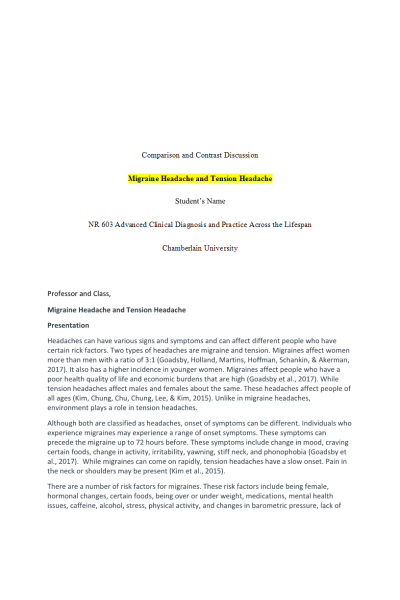NR 603 Week 1 Compare and Contrast Discussion; Migraine Headache and Tension Headache
-
$15.00
| Institution | NR 603 Advanced Clinical Diagnosis and Practice Across the Lifespan |
| Contributor | Sharonda |
Preview of Starting Page…..
Headaches can have various signs and symptoms and can affect different people who have certain rick factors. Two types of headaches are migraine and tension. Migraines affect women more than men with a ratio of 3:1 (Goadsby, Holland, Martins, Hoffman, Schankin, & Akerman, 2017). It also has a higher incidence in younger women. Migraines affect people who have a poor health quality of life and economic burdens that are high (Goadsby et al., 2017). While tension headaches affect males and females about the same. These headaches affect people of all ages (Kim, Chung, Chu, Chung, Lee, & Kim, 2015). Unlike in migraine headaches, environment plays a role in tension headaches.
Although both are classified as headaches, onset of symptoms can be different. Individuals who experience migraines may experience a range of onset symptoms. These symptoms can precede the migraine up to 72 hours before. These symptoms include change in mood, craving certain foods, change in activity, irritability, yawning, stiff neck, and phonophobia (Goadsby et al., 2017). While migraines can come on rapidly, tension headaches have a slow onset. Pain in the neck or shoulders may be present (Kim et al., 2015).
Preview of Last Page…..
Reference
11th European Headache Federation Congress jointly with 31st Congress of the Italian Society for the Study of Headaches : Rome, Italy. 01-03 December 2017. (2017). The Journal Of Headache And Pain, 18(Suppl 1), 111. https://doi-org.chamberlainuniversity.idm.oclc.org/10.1186/s10194-017-081
Charles, A. (2018). The pathophysiology of migraine: implications for clinical management. The Lancet. Neurology, 17(2), 174–182. https://doi-org.chamberlainuniversity.idm.oclc.org/10.1016/S1474-4422(17)30435-0
Frequent episodic tension-type headache. (2019). Retrieved from International Headache Society website: https://ichd-3.org/2-tension-type-headache/2-2-frequent-episodic-tension-type-headache/
Goadsby, P. J., Holland, P. R., Martins-Oliveira, M., Hoffmann, J., Schankin, C., & Akerman, S. (2017). Pathophysiology of Migraine: A Disorder of Sensory Processing. Physiological reviews, 97(2), 553–622. doi:10.1152/physrev.00034.2015
Jackson, J. L., Mancuso, J. M., Nickoloff, S., Bernstein, R., & Kay, C. (2017). Tricyclic and Tetracyclic Antidepressants for the Prevention of Frequent Episodic or Chronic Tension-Type Headache in Adults: A Systematic Review and Meta-Analysis. Journal of general internal medicine, 32(12), 1351–1358. doi:10.1007/s11606-017-4121-z
Kim, B. S., Chung, C. S., Chu, M. K., Chung, Y. K., Lee, C. B., & Kim, J. M. (2015). Factors associated with disability and impact of tension-type headache: findings of the Korean headache survey. The journal of headache and pain, 16, 524. doi:10.1186/s10194-015-0524-6
Kobets, A. (2019). Understanding the Pathophysiology of Migraine Pain. Retrieved from U.S. National Library of Medicine website: https://clinicaltrials.gov/ct2/show/NCT03026101
Weatherall M. W. (2015). The diagnosis and treatment of chronic migraine. Therapeutic advances in chronic disease, 6(3), 115–123. doi:10.1177/2040622315579627
End of Document Preview
| Instituition / Term | |
| Term | Fall Semester |
| Institution | NR 603 Advanced Clinical Diagnosis and Practice Across the Lifespan |
| Contributor | Sharonda |



















